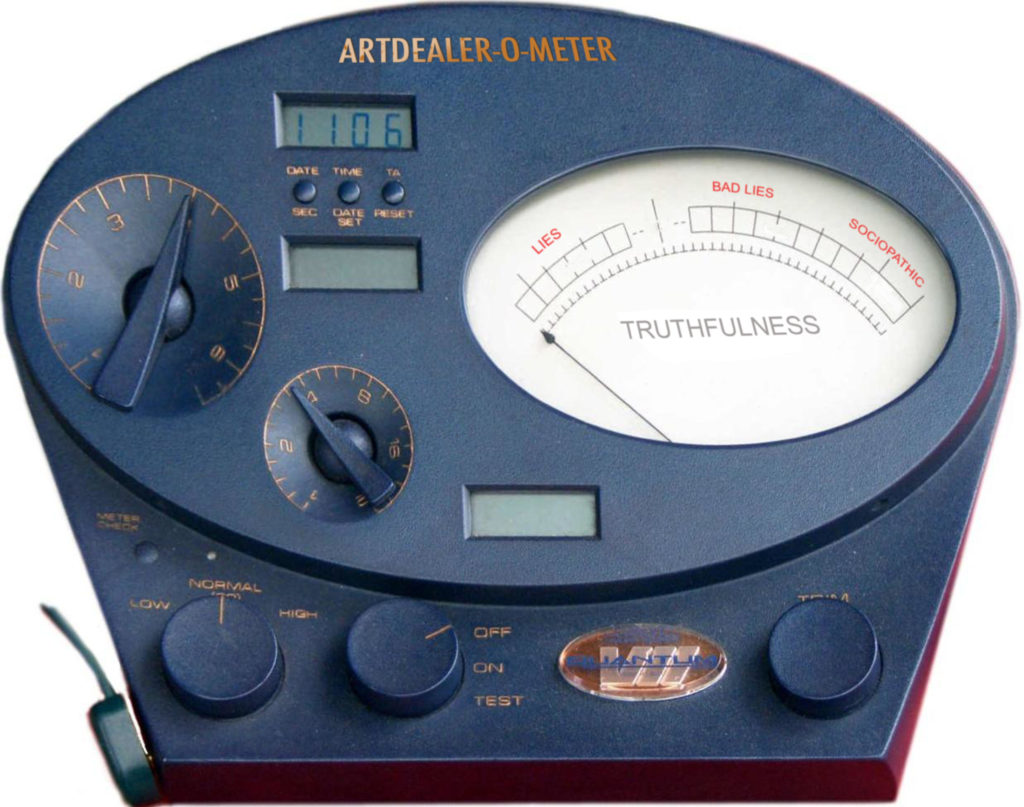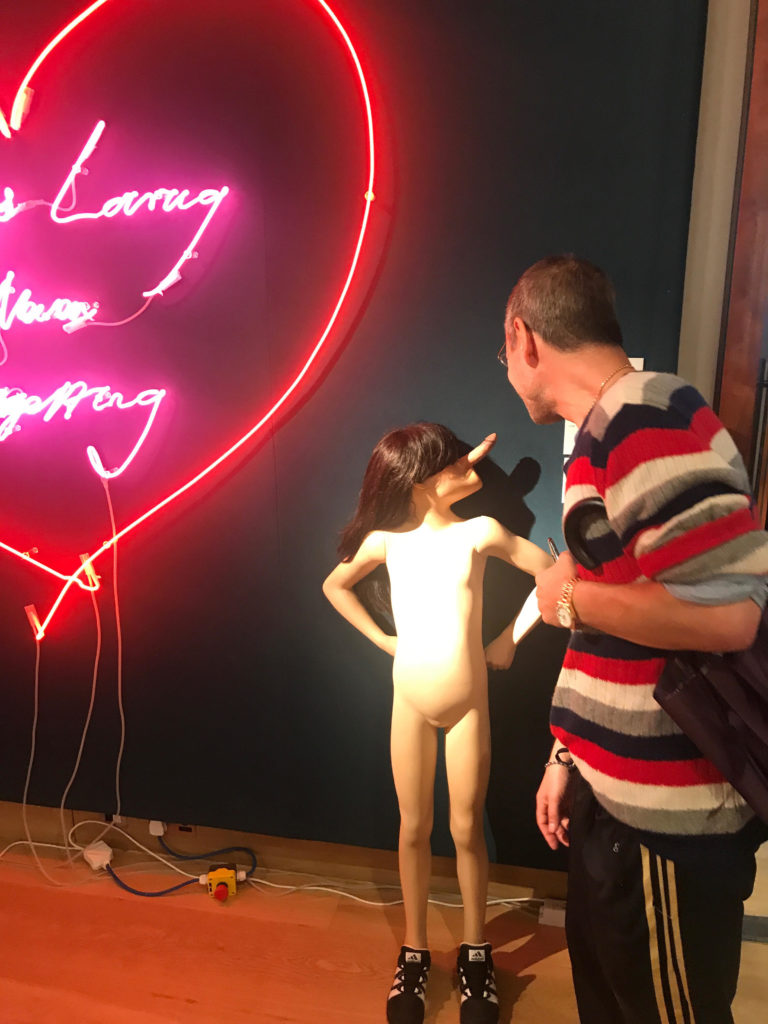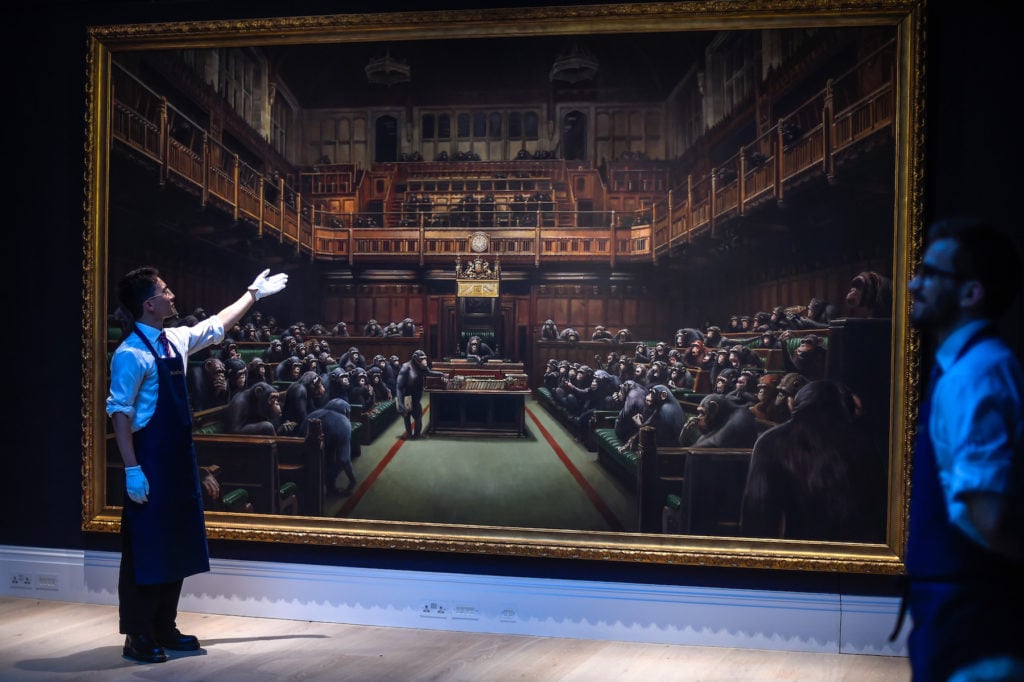Opinion
Is Infantilism the Key to KAWS’s Unstoppable Rise? Kenny Schachter Peers Behind the Scenes at the London and Hong Kong Auctions
Our columnist pulls back the curtain on the swarms of flippers fueling the art market.

Our columnist pulls back the curtain on the swarms of flippers fueling the art market.

Kenny Schachter

Whether we actually live in the wackiest, rockiest economic, social, and political time in history remains to be seen, but there’s no denying it certainly feels that way. Unprecedented art world unpredictability is no exception, and in such a period the deception swirling in the market seems to escalate to dizzying heights, from what I have seen. In direct proportion to the amplification of lies—and I have experienced more fabrications (not the Jeff Koons variety, though those too) in the past three years than in the previous 30—comes the escalation of shitty behavior.
An electroencephaloneuromentimograph (or E-Meter, as time-pressed L. Ron Hubbard devotees call it) purportedly allows Scientologists to see the thoughts of inductees. In English, the dubious machine induces an electrical current through the body and back into the device to measure changes in electrical resistance. But you don’t need an E-anything to divine the intent of (most) art dealers—they want what’s in your pocket, and seem prepared to use any means necessary to get it.

This device comes in handy more and more often these days. Artwork by Kenny Schachter.
A BBC documentary released last month entitled “The $50m Art Swindle” by Vanessa Engle chronicled the exploits of French art dealer Michel Cohen, who in reality stole $55m running a New York gallery in the 1990s before going on the run from the law. (I guess that number doesn’t roll off the tongue as smoothly.)
The documentary could just as easily have been about a handful of art operators I know, especially when it comes to Cohen’s lack of remorse or even understanding that he had done anything wrong, since, as he explains, no one got hurt or had to modify their standard of living. He lives in exile in France, which has no extradition treaty for this variety of embezzlement. In Cohen’s mind, he was going to pay everyone back but simply lost all the money (through trading stock options) and lacked the means to make any more going forward. Creepy how I have heard time and again—including in London last week—of pathological dealers selling a painting, even more than once, that they neither own nor have the authority to sell.

I am the bottom of the top of the bottom. Courtesy of the Art Gorgeous.
I have frequently averred, partially tongue in cheek, that the art world is a cesspool of corruption, an observation that has proven painfully true. I was always cynically optimistic about art’s state of affairs; I’m not so sure anymore. Don’t get me wrong, I passionately care and always will, but the joy is dwindling. Those who love art for art’s sake, rather than a method of turning a quick profit (or trying to, anyway) belong in a vitrine in a natural history museum.
Accounting for the trend of diminishing connoisseurship is the financialization of art (i.e. a focus on its liquidity/tradability) and our dramatically Insta-foreshortened attention spans. I know of a tech billionaire who only buys works depicting iPhones or computers. Gaining entrée to coveted art with a ready secondary market (a phenomenon getting rarer by the second) is akin to getting private placement shares prior to an IPO of an in-demand company—which is also becoming something of an anachronism. Flippers get access to primary pieces through their advisors, through relationships with galleries due to being rich and/or famous, or through downright deceit. Or all the above.

Art appreciation, auction-style. Tracey and the Chapmans. Photo courtesy of Kenny Schachter.
A hedge-funder I know recently bought work by a hot young artist of color (and being female or black certainly helps in that department nowadays) from a gallery show and then promptly resold it right after receiving the invoice—all while the painting remains hanging on the gallery’s wall. And, I know of a double-dealing dealer that hired his friend to engage an LA advisor on his behalf but tripped up when the stalking horse left a message for his friend about their plan, only inadvertently on the advisor’s phone.
This email regarding Belgian artist Harald Ancart sums it up pretty succinctly: “I bought the mountains at auction last week. Pls keep very confidential. Do you think I got a good deal? Do you think you could sell it sometime in the near-ish future? Are you bullish on this market? Seems to be very few exquisite examples and not that expensive for a top caliber youngish artist. Best,”. Why do people swimming in cash need to behave like this? It’s fun for them, they can’t help themselves, and because they can. The inevitable auction caption could read: From the Collection of a Distinguished Belgian Flipper.
Infantilism (the persistence of babyish traits in adulthood) also seems to describe the mindset of those fueling market phenom Brian Donnelly, known “professionally” as KAWS. In fact, it might even constitute an art movement in itself. (KAWS has, after all, minted a fortune by repurposing the cartoon characters from many collectors’ childhoods.) Sotheby’s, however, somehow managed an embarrassing misfire with the former street artist’s work in London—well, it is the city of self-wrought doom and gloom—when its KAWS sold for only $651,000, a sum $250,000 less than what the consigner had bought it for. That result, of course, got promptly trounced in Hong Kong (read on), where you had to effectively step over protesters to enter the auction houses.
Mayfair dealer Damian Delahunty had originally purchased the ill-fated 2015 KAWS’s 2015 painting, called The Final Machine (there’s a joke there but I’ll let it lie—for now), from Per Skarstedt at a recent Art Basel and sold it on to another intermediary, who in turn shifted it to another dealer before it was unloaded again to yet another dodgy dealer (all in about five minutes, are you following me?) before landing at the London auction. Per, meanwhile, has been issuing a whirlwind of terse legal letters in a futile attempt to enforce the non-resale clauses contained in his invoices. (KAWS’s lawyer is fittingly enough Richard Golub (nè Oscar the Grouch), who you may remember from my last column.) If they had any foresight, that cabal of hustlers should have flogged it in Hong Kong, where the seemingly inelastic demand soldiers on, unabated by political unrest.
But first, more on Sotheby’s London, where I heard an “expert” stroll by the featured Jean-Michel Basquiat cover lot, describing it to a potential Middle Eastern bidder as “what’s called a trophy piece, a work that you absolutely must have.” The Italian owner who sold it didn’t think so, though he previously turned down $13 million from Gagosian and a $10 million guarantee the day of the auction. The painting hammered on a bid of £8.5 million (or $10.4 million) below the £9 million low reserve, which means the auction house had to make up the shortfall.

Gallery workers display Banksy’s ‘Devolved Parliament’ prior to a photo call at Sotheby’s on September 27, 2019 in London, England. Photo by Peter Summers/Getty Images.
Which brings me Banksy’s Devolved Parliament, for which the same expert used the word “famous” 10 times to help his client digest. The Middle-Easterner replied: “This is easier for us to understand than the Basquiat.” The Sotheby’s employee (of the month?) went on to tell the story of Banksy’s shredding stunt last year, which rendered the confettied work “legendary and iconic and instantaneously doubled the price.” He went on to relate that there was a banana hidden somewhere in the composition, though it was plainly visible in the hand of one of the monkey parliamentarians. The collector replied, “Ah yes, like The Da Vinci Code.” Um, okay.
Though I was banished to the back of the salesroom the night of the sale to ostensibly keep me out of trouble (though in my case, that strategy never works) I was sitting directly behind the Banksy underbidder (he bowed out at £8.4 million), Matyas Kodl, the Czech proprietor of Prague’s family-owned Galerie Kodl, a dealership and auction business. Though he failed to win the painting (which sold for a downright simian $12 million), he succeeded in avoiding what economists call the winner’s curse—a tendency for the winning bid in an auction to exceed the intrinsic value of an item due to incomplete information, flooding emotions, or any other number of subjective factors. Add to the list wishful or ahistorical thinking and you have a snapshot of a chunk of present auction activity.
Back to KAWS (and, finally, to Hong Kong), the artist has had 888—yes, eight hundred and eighty-eight!—works come to auction in 2019 alone, with nearly three months remaining in the year, surely a record in itself. At Sotheby’s Hong Kong, his painting Kimpsons #1 came in with a record estimate of $6.1 million to $8.67 million. After the London sale, there were understandably jitters in the room.
Sotheby’s staff again took the prize—they work so hard for it!—by calling this work the equivalent of a Cubist Picasso or de Kooning “Woman.” The house also tried to claw back the work’s $5.8 million guarantee before the sale in fear of the strife in town, but there was no need. It fetched $7.4 million. (His record stands at the unfathomable, and somewhat vulgar, amount of $14.7 million from another Sotheby’s Hong Kong sale last April.) Christ, I should go back to practicing law, or change my artist name to KAS (Kenneth Anthony Schachter).
I’m almost done. Sotheby’s continued to slay it (Christie’s doesn’t have a fall contemporary evening sale in Hong Kong) with the crazy sale of Yoshitoma Nara’s Knife Behind Back, which made almost $25 million, with three bidders chasing it above the $20 million mark. The painting that originally sold for $20,000 in 2000 last sold to our friend Damian Delahunty and a London-based partner for $3.3 million in 2016, who it sold on to Delahunty’s client Mark Scheinberg, an Israeli-Canadian businessman and co-founder of the online gambling company PokerStars, which was sold in 2014 to Amaya Gaming for $4.9 billion. There could not be a finer portrait of an art spec-u-lector—a filthy rich white professional gambler who doesn’t need the money, just the kick. I have never encountered a female flipper, by the way.
Sotheby’s new owner, Patrick Drahi, must be a happy camper after the Hong Kong results. But, as Sotheby’s is still an American company—as opposed to Christie’s—don’t look for too much change in the way of public disclosures, besides firing some dead weight and putting more stock (figuratively speaking) into the digital realm, one of Drahi’s specialties. Sotheby’s has also frozen payment terms to successful buyers for the upcoming November sales and instituted a policy of less adventurous guarantee deals, which together should result in less bidding activity.

Frayed around the edges, like the art economy. Leave me alone about it next time you see me please. Photo courtesy of Kenny Schachter.
Concluding (you can breathe a sigh of relief), to the many who think shuffling from fair to auction to biennial is akin to switching seats on the Titanic, neither snow nor rain nor flu (achoo) nor gloom of crap art stays this intrepid correspondent from the swift completion of his appointed art rounds (albeit Hong Kong is a step too far, even for me). The market doesn’t seem to miss a beat, like the Energizer Bunny. Though my patience is as frayed as my ubiquitous track-suit bottoms (as everyone seems inclined to point out to me), I’ll see you at FIAC next week, the November New York auctions, and then Miami Blahsel.